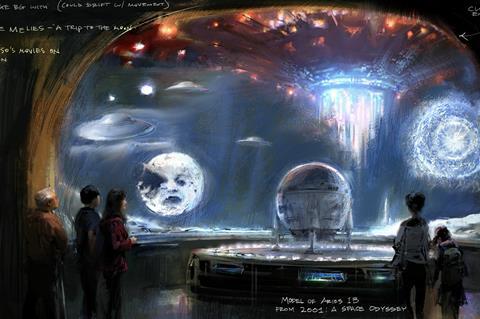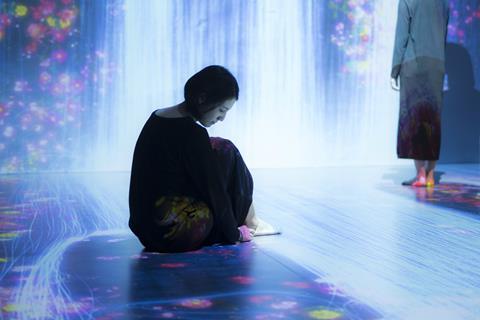
Roughly one year before the anticipated opening of the Academy of Motion Pictures, top brass on Tuesday (4) said the site will house an inaugural long-term exhibition about the evolution of film, and kick off with two temporary exhibitions – the first US retrospective of Japanese animation icon Hayao Miyazaki, and a chronicle of black cinema from 1900-1970.
Academy Museum director Kerry Brougher presided over a lunchtime presentation at the Petersen Automotive Museum in Los Angeles’ Miracle Mile district, opposite the Academy Museum site, which is situated next to LACMA.
The Museum will house three galleries, a library, a project space, two theatres, and an outdoor deck on the fifth floor offering views of the surrounding city. Designed by Renzo Piano, it remains under construction and is an ongoing restoration of the old Saban Building, formerly known as the May Company building built in 1939.
Thus far the Academy has raised $388m through its fundraising efforts spearheaded by Disney chief Bob Iger, and co-chairs Annette Bening and Tom Hanks.
Where Dreams Are Made: A Journey Inside The Movies
Where Dreams Are Made: A Journey Inside The Movies (working title) is the hugely ambitious long-term exhibition that will occupy more than 30,000sq ft and two floors, exploring the evolution of film from its beginnings to its possible futures through evocative settings, objects from the Academy’s collections, and film installations.
Among the highlights will be the Making Of: The Wizard Of Oz installation and the famous pair of Dorothy’s ruby slippers worn by Judy Garland, early film projections, a look at the role played by female pioneers, silent cinema, Hollywood’s ‘Golden Age’, and postwar filmmaking techniques and international cinema movements, and an homage to the Stargate Corridor sequence from Stanley Kubrick’s 2001: A Space Odyssey.
Celebrated production designer Rick Carter, who won Oscars for Avatar and Lincoln, has been serving as what one Museum executive called a ‘guru’ on the exhibition in between trips to the Pinewood in the UK to work on Star Wars: Episode IX.
“This is a humanistic experience… cinema is fundamentally a humanistic experience. It’s whole design is to be inclusive to the viewer,” Carter told Screendaily, adding later: “The whole idea here is how do you evoke what excited you in cinema without dumbing down.”
Hayao Miyazaki, Regeneration: Black Cinema 1900–1970 exhibits
Turning to the institution’s first temporary exhibitions, the Museum’s director Brougher said the Hayao Miyazaki (working title) retrospective will be presented in collaboration with the filmmaker’s Studio Ghibli. Exhibitions curator said the exhibit will encompass all 11 of the master’s features, as well as production materials, installations, and items that have never left Studio Ghibli before.
This exhibition will be followed in autumn 2020 by Regeneration: Black Cinema 1900–1970, which was described as a revisionist exhibition chronicling the under-recognised history of African-American filmmakers in the development of American cinema until just after the Civil Rights era. The exhibit will feature restored films and will travel throughout the US, and is the recipient of the annual Sotheby’s Prize supporting museums to break new ground and facilitate exhibitions that explore overlooked or under-represented areas of art history.
The museum’s 34-foot-high project space will open with an interactive work by the Tokyo-based interdisciplinary collective teamLab (pictured). Additional exhibitions will include Making Of: The Wizard Of Oz, and an Oscars experience.

Academy Awards History And Oscars Experience
The Academy Awards History And Oscars Experience will look back at the history of the show, its glamour and controversies, and the ways in which the ceremony has evolved to mirror culture. Visitors will then enter a gallery offering an Oscars experience in which they will get their own photo opportunity and Oscar moment.
The Museum’s public programmes will include panel discussions, symposia, gallery talks, and other public events. The 288-seat Ted Mann Theater will offer daily thematic and exhibition-related screenings, and special showings and events will be held at the 1,000-seat David Geffen Theater.
“We want the Academy Museum to add to the public’s understanding of the evolution of the art and science of filmmaking around the world – to increase appreciation for this great art form and encourage people to examine the role of movies in society,” said Brougher. “At the same time, we want to bring to life the most important reason of all for caring about the movies – because they’re magic. That’s why we intend to transport our visitors into a world that exists somewhere between reality and illusion. Like the experience of watching a movie, a trip to the Museum will be a kind of waking dream in which visitors feel as if they’ve slipped through the screen to see how the magic is created.”
Brougher and Deborah Horowitz, the Museum’s deputy director of creative content and programming, have assembled a creative team that includes: acting head of curatorial affairs Doris Berger; the aforementioned Jessica Niebel; associate curator and head of film programmes Bernardo Rondeau; assistant curators J. Raul Guzman, Dara Jaffe, and Ana Santiago; film programme coordinator Robert Reneau; producer Brooke Breton (Avatar); sound designer Ben Burtt (Star Wars: Episode IV, E.T. The Extra-Terrestrial); staff from the Academy’s Margaret Herrick Library and Academy Film Archive, Academy governors and members, the Museum’s advisory committee on inclusion, and a range of film scholars and filmmakers.























No comments yet